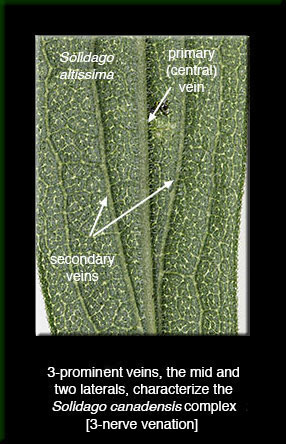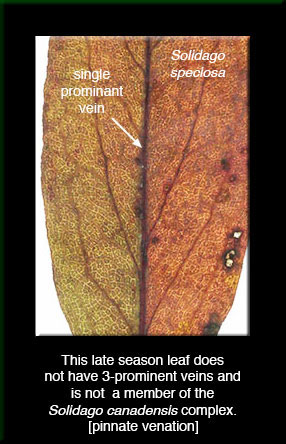Online help for the identification of Goldenrods can be found at these sites: 1, 2, 3, 4, 5, 6—and Goldenrod galls at these sites: A, B, C, D.
Update Notice
This notice will remain until the page is updated to accomodate the genetic results that have returned the three Oligoneuron species back into the genus Solidago. In the meantime,
Dr.Thomas Rosburg has provided a pdf key to the Iowa Species of Solidago which you may download here.
Occurance: The USDA plant site reports 75 species and 144 taxa (in the U.S.) for the Genus Solidago—thirteen species are shown in Iowa.
In The Vascular Plants of Iowa Eilers and Roosa report that fourteen species of Solidago have been found in Iowa. However, three of these species S. ptarmicoides, S. riddellii, and S. rigida are sometimes placed in the genus Oligoneuron —as Oligoneuron album, Oligoneuron riddellii, and Oligoneuron rigidum, respectively (See USDA website). One species, S. altissima, was previously considered a separate species—then it was thought to be a variety of S. canadensis (S. canadensis var. scabra). Now, according to the Flora of North America (FNA) it is considered a single species again, but with two subspecies (subsp. altissima and subsp. gilvocanescens. The grass-leaved goldenrod (S. graminifolia) has moved to the genus Euthamia and is now known as Euthamia graminifolia (common goldentop). As of March 2017, another species, Solidago jejunifolia, has been added to the list of Iowa goldenrods. At this writing, FNA still has it listed as a synonym for Solidago speciosa.
Distribution information for the U.S. is available at BONAP and for Iowa at An Illustrated Guide to Iowa Prairie Plants. Nine species—indicated below in bold font—have been reported in Johnson county. Finally, at the top of this page is a navigation bar with a link to "Plant inventories". If you have an unknown plant that was found in one of the inventoried areas you can compare it to the plants already known to have existed in that area.
Solidago, like Aster, is one of our most difficult genera. Natural hybridization frequently occurs and the species are also highly plastic. For proper study full specimens, showing subterranean parts and basal leaves as well as the whole flowering stem, are essential. Identification of fragmentary specimens is safe only after long familiarity with the group.
Gray's Manual of Botany Eighth Edition (footnnote Page 1381).
Goldenrod Species in Iowa


Solidago altissima - Tall goldenrod, Late goldenrod
Solidago canadensis - Canada Goldenrod
Solidago flexicaulis - Zig-Zag Goldenrod
Solidago gigantea - Smooth Goldenrod
Solidago hispida - Hairy Goldenrod
Solidago missouriensis - Missouri Goldenrod
Solidago nemoralis - Gray Goldenrod
Solidago patula - Roundleaf Goldenrod
Solidago ptarmicoides (Oligoneuron album) - Prairie Goldenrod
Solidago riddellii (Oligoneuron riddellii) - Riddell's Goldenrod
Solidago rigida (Oligoneuron rigidum) - Stiff-leaved Goldenrod
Solidago sciaphila - Cliff Goldenrod
Solidago speciosa - Showy Goldenrod
Solidago uliginosa - Swamp Goldenrod
Solidago ulmifolia - Elm-leaved Goldenrod
Euthamia graminifolia - (Solidago graminifolia) Grass-leaved Goldenrod
Clues to Identification (for the nine species in Johnson county, IA)
Short plants (less than 3 feet at maturity)
Solidago flexicaulis—mesic woodlands
Solidago missouriensis—open plains
Solidago nemoralis—sterile soils, old fields
Tall plants (more than 4 feet at maturity)
Solidago canadensis—involucre less than 3mm
Solidago altissima—most common, mesic soils
Solidago gigantea—moist soil, hairless stem
Solidago speciosa—single prominant leaf vein
1) Three species are short plants usually less than 3 feet tall—S. flexicaulis (prefers mesic woodlands), S. missouriensis (prefers open plains), and S. nemoralis (prefers sterile soils and old fields). S. flexicaulis may have a zig-zag stem and its leaves are more than 3 cm wide (ovate, petioled, and dentate). S. missouriensis leaves are less than 2.5 cm wide and linear-lanceolate.(cauline leaves oblanceolate decreasing in size from base to inflorescence).
2) The four taller species are generally taller than 3 feet—usually 5 or 6+ feet tall. Three of these are often confused: S. gigantea, S. altissima, and S. canadensis. These are sometimes collectively referred to as the tall goldenrods. The taxonomy of these species is uncertain and some botanists prefer to treat two of them as one by making S. altissima a variety of S. canadensis. Since the FNA regards them as three separate species, we will take their approach here. They are usually distinguished by the hairiness of their stems, the serration of their leaf margins and the size of their floral involucres. S. gigantea has smooth (hairless) often reddish stems below the inflorescence. S. canadensis has hairy stems below the inflorescence but the hairs diminish and disappear further down the stem. S. altissima stems may be hairy further down the stem, but hairiness can decrease as the plant ages. It appears that none of these distinctions are 100% foolproof. In a 2015 paper, John Semple et al. had this to say, "Morphology alone may not be sufficient to determine the true limits of these subgroups. The subgroups are logical but not necessarily phylogenetically correct because inflorescence branching characteristics and variation in stem pubescence may not be phylogenetic markers. Molecular data is needed to provide guidance."
The floral heads are smaller on S. canadensis. The length of its involucres range from 1.7 to 2.5 mm. Those of the other two species are 2.5-4 mm long. The number of disc florets per head provide another distinction. For S. gigantea the number is 7-12 compared to 3-6 in the two other species. Finally, the laminae (fused petals) of the ray florets tend to be longer than 1.5 mm for S. gigantea and 1.5 mm or less in the other two species.
The fourth member of the tall species is S. speciosa which is usually 4 to 5 feet tall with thick narrow leaves and reddish stems. Below the inflorescence, the stem has few if any hairs. But, the characteristic that distinguishes this plant from the other "tall goldenrods" is its pinnately nerved leaves. The other members of this group have mid-caudal leaves with 3-nerve venation (see photos above).
3) Two species seem different enough from the rest to be considered for inclusion in different genera.
These are first, S. rigida (Oligoneuron rigidum) which has two kinds of leaves, relatively large and petioled basal leaves and smaller cauline leaves which are often directed upward along the stem; and second, S. graminifolia (Euthamia graminifolia) which has three veins running the length of its grass like leaves.
4) S. speciosa and S. nemaralis have leaves that are largest at the bottom and are progressively smaller moving up the stem. Beneath the inflorescence, S. speciosa is smooth stemmed while S. nemoralis has pubescent stems.
5) Only two species of goldenrod are known to routinely play host to the gall forming fly (Eurosta solidaginis). These are S. altissima (with hairy stems) and S. gigantea (with smooth, sometimes reddish, stems). Apparently, the fly finds S. canadensis rarely suitable for its purposes. There is information about this relationship on the 37 minute video - The Goldenrod and the Gallfly.
Interestingly, some members of the S. altissima and S. gigantea species have evolved a method called "ducking" which dissuades the Eurosta fly from depositing its eggs in these plants.
Recent Publication: Flora of the Chicago Region A floristic and Ecological Synthesis (2017) Gerould Wilhelm and Laura Rericha, is a nearly encylopedic update and extension of the popular Plants of the Chicago Region. Here are a few quotes about the Solidago species in the Chicago region:
Page. 1059. Solidago altissima Tall Goldenrod [is] virtually indistinguishable vegetatively from Solidago canadensis, with which it often associates….
Page 1060. [Solidago_altissima] Some consider this plant to be a subspecific taxon of Solidago canadensis, but Tall Goldenrod blooms later and the involucres are always more than 3 mm long. 28 Aug - 22 Oct. FACU. C=1
Page 1061. [Solidago canadensis] ...and see the list of leaf beetles that breed on Solidago altissima, as these insects also breed on Solidago canadensis. In addition, the galls that occur on Tall Goldenrod also occur on Canada Goldenrod
If you have a chance to explore this book I would like to recommend the Forward (p. xi) written by the publications chairman, Indiana Academy of Science, Bill McKnight and the End Note (P. 1367) written by the senior author Gerould Wilhelm.